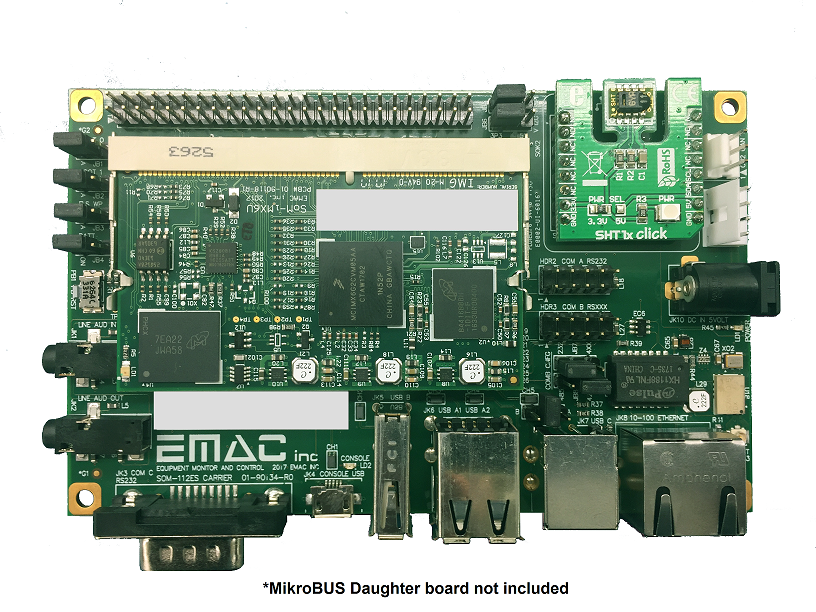EMAC has released a Request-A-Quote site with additional features and functionality.
XP-E Server-In-A-Box
XP Embedded is an embedded version of the Microsoft® Windows XP ® Operating System specifically designed to address the needs of dedicated and embedded systems OEMs. Based on Windows XP Professional with Service Pack 2, Windows XPE is complementary to Windows CE. Windows XP Embedded is advantageous for solutions that are highly interconnected, require full Win32 binary compatibility, and/or are tightly integrated with Microsoft BackOffice® family products in line-of-business and Point Of Sale (POS) systems. Windows CE is more advantageous in applications where size and cost are critical however, CE is much more difficult to utilize.
Windows XP already provides an excellent foundation for building embedded systems: a high-performance kernel, pre-emptive multitasking, scalable asynchronous I/O model, rich layered services, and the ubiquitous Win-32 API. However, there are still many needs that must be addressed including fault resilience, error recovery, target footprint management, solid-state operation, remote device management/troubleshooting, and a non-standard/non-existent UI. Windows XP Embedded adds these and other capabilities to Windows XP. It is a superset of Windows XP adding new features and target design tools that make it suitable to a wider range of embedded applications.
The EMAC Server-In-a-Box (SIB) can run XP Embedded as its Operating System and as such retains all of the networking and communications capabilities one would expect of such an operating system. Right out of the box, the SIB is configured for Ethernet, serial IP, serial terminal, and raw serial connections. Other devices, including PPP modem links, may be added and configured by the user.
Based on the same binaries as Microsoft Windows XP Professional, Windows XP Embedded also allows you to reduce time to market by taking advantage of a familiar programming model and a powerful set of tools. Windows XP Embedded delivers industry-leading reliability, security, and performance features and enhancements. The operating system software also provides the latest multimedia and Web browsing capabilities and contains extensive device support.
In addition, Windows XP Embedded incorporates the latest embedded-enabling capabilities, such as support for multiple boot, storage, deployment and management technologies. Based on the Win32 programming model, Windows XP Embedded allows you to reduce time-to-market by using familiar development tools such as Visual Studio.NET, working with commodity PC hardware and seamlessly integrating desktop applications, drivers, and services. The Windows Embedded Studio tools streamline the end-to-end development process and enable developers to rapidly configure, build and deploy smart designs with rich applications.
The EMAC XP Server-In-a-Box (SIB) provides an embedded server that is capable of running virtually any Windows XP application program. Windows XP Embedded is the componentized version of the leading desktop operating system, enabling rapid development of the most reliable and full-featured connected devices. Based on the same binaries as Windows XP Professional, Windows XP Embedded enables embedded developers to individually select only the rich features they need for customized, reduced-footprint embedded devices. This operating system is very well suited for applications requiring a Graphic User Interface (GUI).
XPE FEATURES
Device Driver Rollback: If issues occur when new device drivers are added, a copy of the previously installed driver is saved, enabling a user to roll back to the original device.
Universal Serial Bus (USB): Supports a wide array of USB peripherals such as scanners, mice, keyboards, and so on.
Universal Plug and Play (UPnP): Universal Plug and Play (UPnP) is an architecture for pervasive peer-to-peer network connectivity of devices of all form factors, including intelligent appliances and wireless devices. UPnP is a distributed, open networking architecture that leverages TCP/IP and the Web to enable seamless-proximity networking in addition to control and data transfer among networked devices in the home, office, and everywhere in between.
Pre-emptive Multi-tasking Architecture: Designed to allow multiple applications to run simultaneously. Includes enhancements to ensure great system response and stability.
Encrypting File System (EFS) with Multi-user Support: Encrypts each file with a randomly generated key. The encryption and decryption processes are transparent to the user. In Windows XP Embedded, EFS can allow multiple authorized users access to an encrypted document.
Flexible Boot and Storage Options: In addition to magnetic disk, boot capability is offered for alternative nonvolatile (persistent) read/write storage devices such as Flash ROM and battery-backed RAM. Boot from CDROM is possible when the El Torito bootable CD-ROM driver is used in combination with the Enhanced Write Filter and ROM. Windows XP Embedded also provides support for DiskOnChip Flash, PCMCIA-ATA, Compact Flash, MultiMediaCard, and MemoryStick.
Enhanced Write Filter: Enhanced Write Filter (EWF) re-routes selected disk I/O to memory or another storage medium, thus providing the appearance to the operating system that your read-only storage is writable.
Internet Explorer: Provides the latest Web browsing technologies including visual refresh, playback support for Flash and Shockwave files, and privacy enhancements.
802.11: Windows XP Embedded supports 802.11 wireless LAN technology that provides high bandwidth connectivity without wires.
802.1X: 802.1X provides secure access to the network to support wireless LANs and Ethernet. It enables interoperable user identification, centralized authentication, and dynamic key management and can secure both wired and wireless LAN access.
Infrared Data Association (IrDA): Support Windows XP Embedded fully supports standards for this low-cost, low-power, cable replacement technology that enables any device to communicate from point-to-point when two devices are in line sight of each other.
Embedded-Specific Features: Windows XP Embedded with Service Pack 1 incorporates the latest embedded-enabling capabilities, focusing on remote deployment and maintenance scenarios.
Remote Boot: The Remote Boot service for Windows XP Embedded with Service Pack 1 enables a Windows XP Embedded-based client device to boot using an image downloaded from a server. It also enables Windows XP Embedded-based devices to operate without requiring persistent storage, such as a hard drive or Flash RAM.
Device Update Agent: Windows XP Embedded with Service Pack 1 enhances support for in-field servicing with Device Update Agent (DUA). DUA is designed to address scenarios where it is necessary to incrementally update or service a Windows XP Embedded device that has been previously deployed to the field.
Footprint Estimator: Using Footprint Estimator, embedded developers can now estimate the footprint size of individual components and their dependencies, as well as macro components, prior to adding them to a configuration. This enables developers to proactively know what the impact of a given component will have on the image size, thereby avoiding guesswork and saving development time.
System Deployment Image (SDI) Manager: The System Deployment Image (SDI) service enables you to quickly deploy run-time images to your Windows XP Embedded-based devices. The SDI feature enables easier staging of runtime images on your development workstation and preparation of images for fast deployment. It also provides an easier method for transferring the runtime image from the development system to the device.
Multilingual User Interface (MUI) Language Packs: Windows XP Embedded with Service Pack 1 has support for over 20 languages. Windows XP Embedded MUI Language Packs enable you to save time and effort in localizing your solution for multiple markets by enabling you to develop your customized operating system image only once rather than requiring you to localize each version from the ground up. By simply adding the desired language pack to your base English configuration, the user interface will be localized into your chosen language.
SIB XP EMBEDDED FEATURES
IIS
The web server is running Microsoft Internet Information Server IIS, which provides HTTP and FTP services that use Windows® XP usernames and passwords for authentication. This adds security and ease of user control.
IIS FTP Server
The FTP Server allows files to be copied to and from the SIB on a TCP/IP network. This component integrates with IIS, enabling the user to transfer files using a standard web browser.
Integrated Security
The robust security architecture of Windows XP professional Service pack 2 is used consistently across all system components, with authentication tied to controlled access to all system resources. IIS integrates into the Windows security model and operating system services such as the file system and directory. Because IIS uses the Windows user database, administrators do not need to create separate user accounts on every Web server, and Intranet users need only to log on to their network once. IIS automatically uses the same file and group permissions as the existing file, print, and application servers.
Advanced Write Filter (EWF)
The EWF provides a means for protecting a disk volume from disk writes. EWF allows the operating system to boot from read-only media and all writes to the EWF protected volume are redirected to an overlay. Any subsequent reads of the data will be read from the overlay. The EWFMGR utility can be used to commit changes to a protected volume. This is extremely useful for protecting an embedded disk from corruption.
First Boot Agent & The Cloning Component
One of the headaches associated with deploying desktop XP is the Licensing and SID registration. This process makes the use of a "Golden Drive" difficult if not impossible. With the use of First Boot Agent and the Cloning Component a "Golden Drive" can be created a replicated as many times as required with no special setup or registration required.
Easy To Manage
Permissions to control access files and directories can be set graphically, because IIS uses the same Windows Access Control Lists (ACLs) as all other Windows services, such as file sharing or Microsoft SQL ServerTM permissions. Permissions for the Web server are not separate from other file services, so the same files can be securely accessed over other protocols, such as FTP, CIFS/SMB, or NFS without duplicating administration.
Telnet Server
The SIB includes a standard TELNET Server which will allow remote TELNET (command prompt) access over a LAN or the Internet. Once simple network configuration has been performed, you may telnet to your SIB from any computer which has network access to the SIB.
Terminal Server Remote Desktop
The SIB Comes with Remote Desktop. Remote Desktop provides remote access to the desktop of the SIB. The SIB will prompt for a user name and password. When connected, the access machine will have a window which displays the desktop of the SIB and allows you to perform operations as if you where at the SIB's console. Using System Management Server (SMS) allows the management of the SIB across a wide Enterprise network. An administrator at one desk can manage all the systems across a single interface.
Device Update Agent
The Device Update Agent (DUA) provides an incremental update service to update a deployed SIB's XPE image with the latest application, drivers, and QFEs. Also Software Update Services (SUS) provides a complete servicing solution for the distribution of XP Security updates.
Windows Scheduler
The SIB comes with the standard Windows scheduler. This is a program that runs in the background, executing specified commands at specified times. Programs can be executable binaries or shell scripts.
Users
The SIB comes setup to auto login as the Administrator. Other users can be added as requested.
Event Log
The Event Log is a DLL library that runs as part of Services.exe. It stores and retrieves Security, System, and Application events that can be viewed by an event viewer.
Custom Components
EMAC can optionally add any XPE component you require additionally we can provide XPE builds to suite the application need. For example we can prohibit <right click> Properties capability of the Desktop.




